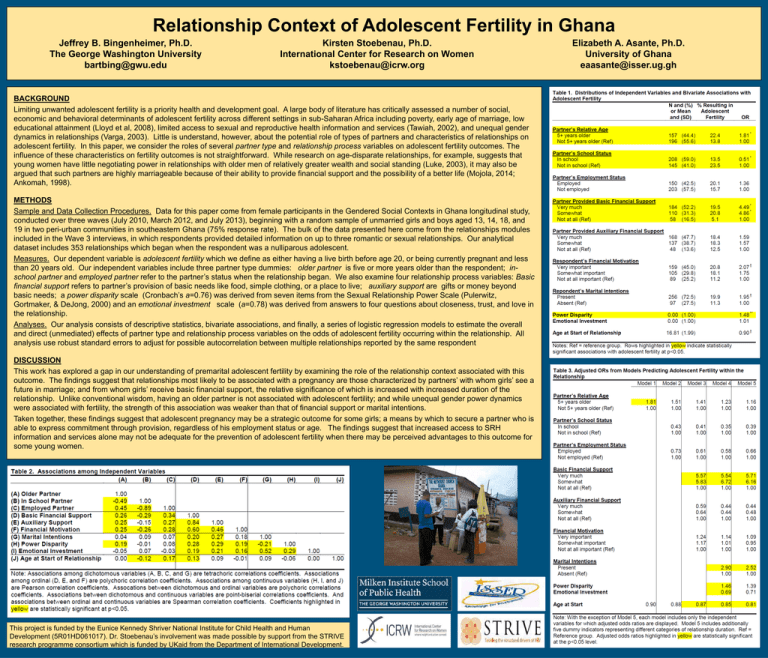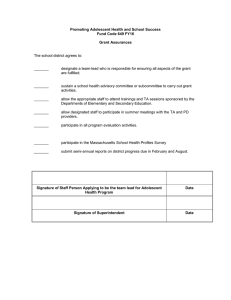
Relationship Context of Adolescent Fertility in Ghana
Jeffrey B. Bingenheimer, Ph.D.
The George Washington University
bartbing@gwu.edu
Kirsten Stoebenau, Ph.D.
International Center for Research on Women
kstoebenau@icrw.org
BACKGROUND
Limiting unwanted adolescent fertility is a priority health and development goal. A large body of literature has critically assessed a number of social,
economic and behavioral determinants of adolescent fertility across different settings in sub-Saharan Africa including poverty, early age of marriage, low
educational attainment (Lloyd et al, 2008), limited access to sexual and reproductive health information and services (Tawiah, 2002), and unequal gender
dynamics in relationships (Varga, 2003). Little is understand, however, about the potential role of types of partners and characteristics of relationships on
adolescent fertility. In this paper, we consider the roles of several partner type and relationship process variables on adolescent fertility outcomes. The
influence of these characteristics on fertility outcomes is not straightforward. While research on age-disparate relationships, for example, suggests that
young women have little negotiating power in relationships with older men of relatively greater wealth and social standing (Luke, 2003), it may also be
argued that such partners are highly marriageable because of their ability to provide financial support and the possibility of a better life (Mojola, 2014;
Ankomah, 1998).
METHODS
Sample and Data Collection Procedures. Data for this paper come from female participants in the Gendered Social Contexts in Ghana longitudinal study,
conducted over three waves (July 2010, March 2012, and July 2013), beginning with a random sample of unmarried girls and boys aged 13, 14, 18, and
19 in two peri-urban communities in southeastern Ghana (75% response rate). The bulk of the data presented here come from the relationships modules
included in the Wave 3 interviews, in which respondents provided detailed information on up to three romantic or sexual relationships. Our analytical
dataset includes 353 relationships which began when the respondent was a nulliparous adolescent.
Measures. Our dependent variable is adolescent fertility which we define as either having a live birth before age 20, or being currently pregnant and less
than 20 years old. Our independent variables include three partner type dummies: older partner is five or more years older than the respondent; inschool partner and employed partner refer to the partner’s status when the relationship began. We also examine four relationship process variables: Basic
financial support refers to partner’s provision of basic needs like food, simple clothing, or a place to live; auxiliary support are gifts or money beyond
basic needs; a power disparity scale (Cronbach’s a=0.76) was derived from seven items from the Sexual Relationship Power Scale (Pulerwitz,
Gortmaker, & DeJong, 2000) and an emotional investment scale (a=0.78) was derived from answers to four questions about closeness, trust, and love in
the relationship.
Analyses. Our analysis consists of descriptive statistics, bivariate associations, and finally, a series of logistic regression models to estimate the overall
and direct (unmediated) effects of partner type and relationship process variables on the odds of adolescent fertility occurring within the relationship. All
analysis use robust standard errors to adjust for possible autocorrelation between multiple relationships reported by the same respondent
DISCUSSION
This work has explored a gap in our understanding of premarital adolescent fertility by examining the role of the relationship context associated with this
outcome. The findings suggest that relationships most likely to be associated with a pregnancy are those characterized by partners’ with whom girls’ see a
future in marriage; and from whom girls’ receive basic financial support, the relative significance of which is increased with increased duration of the
relationship. Unlike conventional wisdom, having an older partner is not associated with adolescent fertility; and while unequal gender power dynamics
were associated with fertility, the strength of this association was weaker than that of financial support or marital intentions.
Taken together, these findings suggest that adolescent pregnancy may be a strategic outcome for some girls; a means by which to secure a partner who is
able to express commitment through provision, regardless of his employment status or age. The findings suggest that increased access to SRH
information and services alone may not be adequate for the prevention of adolescent fertility when there may be perceived advantages to this outcome for
some young women.
.
This project is funded by the Eunice Kennedy Shriver National Institute for Child Health and Human
Development (5R01HD061017). Dr. Stoebenau’s involvement was made possible by support from the STRIVE
research programme consortium which is funded by UKaid from the Department of International Development.
Elizabeth A. Asante, Ph.D.
University of Ghana
eaasante@isser.ug.gh





